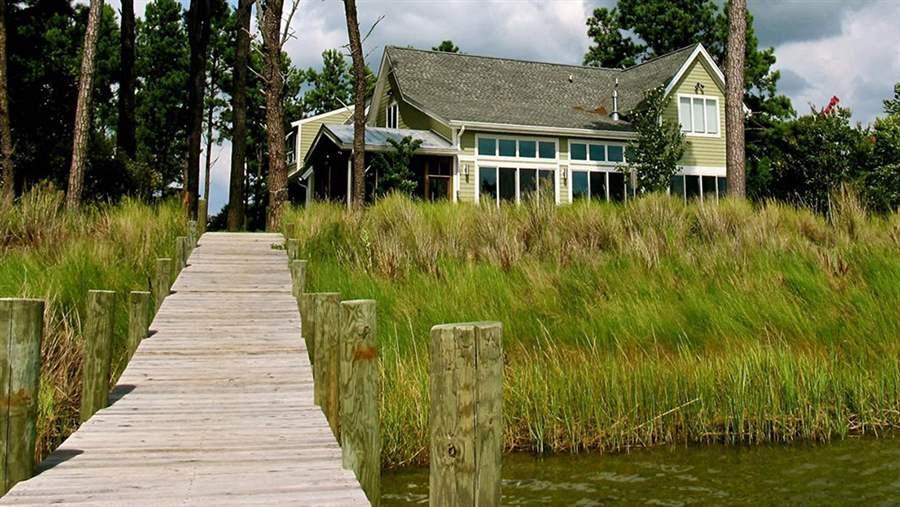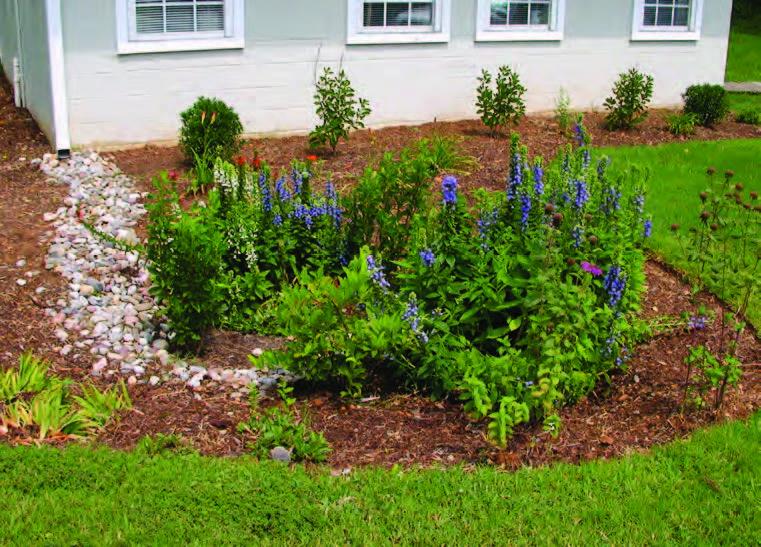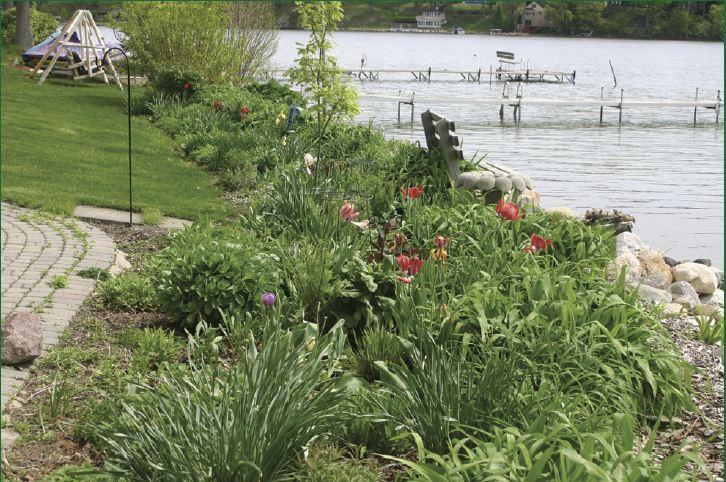Anne Arundel County is lucky to have over 533 miles of shoreline. It offers stunning views, an incredible diversity of recreational opportunities, and supports a vast array of fish, shellfish, and wildlife that are iconic to the Chesapeake Bay. As a waterfront homeowner, the actions you take to manage and protect your property are essential for preserving our waterways as a special place for future generations. By offering opportunities to waterfront homeowners, the information below are simple ways to protect and enhance waterfront properties. What you and your neighbors do to sustain or improve water quality will have positive effects well into our future.
Where the land meets the water is an amazing area full of life with many plants, animals, and fish that spend all or part of their lives. How the waterfront, including the upland, wetland, and water areas are managed determines waterway health. An undeveloped shoreline will have a mix of trees and shrubs, flowers, grasses (native), ferns, and aquatic plants in the nearshore areas. This natural vegetation buffer helps keep our streams, creeks, and rivers healthy by protecting the shoreline from erosion; providing homes, food, and refuge for fish and wildlife; and filtering pollutants from runoff.
Critical Area Law - Protecting Sensitive Lands
In 1984, growing recognition of the importance of this land closest to the tidal waters of the Bay, led to passage of the Chesapeake Bay Critical Area Law. Development or other activities in this 1,000-footwide strip—the Critical Area— disproportionately affect both Bay and tributary water quality. If you live within 1,000 feet of tidal waters or tidal wetlands, you live in the Critical Area. The law mandates additional care when grading, clearing, pruning or clearing invasives.
The 100-foot land strip closest to the water—known as the Critical Area Buffer—has even more stringent requirements. Proper maintenance of trees and shrubs, with little or no use of pesticides, herbicides and fertilizers is especially important since these chemicals can wash or seep into surrounding waters. Since the Critical Area encompasses such a large swath of land, the Critical Area Commission (CAC) relies on citizen oversight for possible violations. The Anne Arundel County Department of Inspections and Permits enforces critical area regulations. Landowners must receive approval for disturbance of soil or vegetation within this zone, including the building of any new structure. More information about Anne Arundel County's Critical Area Program is available here.
To determine if your property is located within the Critical Area, click here.
Best Practices for Waterfront Property Owners
Waterfront living provides a lifetime of memories. Recognizing your role in caring for the shoreline ensures that you—as well as future generations—will be able to enjoy our shared marine resource.
Once they enter the storm drain system, hazardous chemicals end up in the Bay, harming fish, birds, and other wildlife. Always take toxic household and yard products to a Household Hazardous Waste Collection Day. Click here from more information and schedule.

As a waterfront property owner you undoubtedly want to protect your investment and its unique shoreline environment. Protecting a shoreline from accelerated erosion without installing a seawall or bulkhead, can be challenging, but there are alternatives to seawalls. There are many techniques available to address shoreline erosion while supporting the ecosystem and protecting your property. Each site is unique and therefore generally requires a customized solution using a variety of different methods. Understanding shoreline erosion and developing solutions can be very simple or complex depending on the site characteristics.
Characterizing your site starts with simply observing the conditions on and around your property. In many cases you will need the assistance of a professional to complete the assessment which will provide an understanding of the interactions between coastal, geologic, and ecological processes at a site. A thorough assessment of your site is the first step towards protecting both your property and the environment and will allow you to better understand the opportunities and constraints of your property. This step allows you to determine if action is required, and if so, which approaches will be the most effective.
To learn more about "living shorelines," a design approach that both protects property and preserves the natural values of the tidal interface, visit MD DNR's "Living Shoreline" page.
Some waterfront homeowners in Anne Arundel County utilize a septic system, although some communities have converted to public sanitary sewer systems. Owners of private septic systems have a responsibility to protect their family’s health, as well as to protect the surface and groundwater from contamination.
Properly functioning systems are designed to remove most disease-causing human pathogens, but generally are NOT designed to remove or treat water-soluble nutrients or pollutants. The more water and material that goes into your septic system, the more that comes out into your drain field. Recent research on septic systems located in sandy soils has found both phosphorus and nitrates migrated underground over 150 feet from drain fields. If these nutrients seep underground into the lake, aquatic plant growth and algae blooms are likely results.
Malfunctioning systems are especially harmful. Effluent from failed systems can result in direct contamination of well or surface water and could cause serious human health risks. Reasons for septic system failure may include advanced age, overloading, poor site placement and/or poor maintenance.
EVIDENCE OF A MALFUNCTIONING SEPTIC SYSTEM:
- Sewage backing up in the basement or drains.
- Ponded water or wet areas over the drain field.
- Bright green grass over the drain field.
- A dense stand of aquatic plants along only your shoreline.
- Sewage odors.
- Bacteria or nitrate in nearby well water.

If you're interested in upgrading your existing waterfront septic system to a less polluting alternative, the Anne Arundel Health Department has grants to assist with that work.
Many activities we conduct near the waterfront, in our lawns and gardens and around our home, impact water quality. These activities are even more critical to waterfront homeowners because runoff doesn't have far to travel before reaching the water. When it rains or the snow melts, the water runs off streets, driveways, rooftops and lawns across the landscape and picks up various pollutants like oils, greases, nutrients, fertilizers and sediment. Impervious surfaces speed up the flow of runoff from the landscape and prevent water from soaking into the ground where it can be naturally cleansed by microorganisms that live in the soil.
Solution: Address runoff before it leaves your property. Better yet, keep water on your property for use in areas such as your garden. Redirect downspouts away from hard, paved surfaces into vegetated areas, such as a rain garden, or into a rain barrel for later use in the garden. Rain gardens are growing in popularity because they look great and filter pollutants out of runoff allowing clean water to infiltrate and replenish groundwater supplies. Use porous landscaping materials, such as brick paving stones, sand or gravel beds and mulched areas, allowing spaces where water can infiltrate around and through the materials.
The key to successfully managing rain on your property is to Slow it down, Spread it out, Soak it up. For some simple (and beautiful) ways you can capture stormwater visit the Anne Arundel County Watershed Stewards for ideas.


If you have native vegetation along your shoreline, consider yourself and the local wildlife fortunate. A mature native buffer represents many years of nature at work and discourages undesirable, exotic plants and animals while attracting songbirds, butterflies, and other wildlife.
If you have lawn to the water’s edge, a simple, no-cost way to get started in restoring your shoreline is to stop mowing next to the water. Seeds in the soil will germinate and valuable native plants will begin to reappear. If you have lawn to the water’s edge and would like to play a more active role in restoring your shoreline, you can replant native trees, shrubs, grasses and wildflowers to attract songbirds and butterflies. The main area where water runs off your property is the best location to start planting to improve water quality. You can create a natural, appealing waterfront landscape while eliminating expensive and time-consuming lawn care.
Natural shorelines contain a lush mixture of native grasses, flowers, shrubs and trees that help to filter polluted runoff and provide important habitat for animals in the water and on the land. The trees, shrubs and plants not only help shelter and create privacy for the homeowner, but may also act as a noise buffer. Larger areas of natural shoreline provide more benefits. However, any amount of natural shoreline is better than none.
The US Fish and Wildlife Service has produced the "Native Plants for Wildlife Habitat and Conservation Landscaping" native plant guide specific to the Chesapeake Bay Watershed.
Funding for Living Shorelines
Living shorelines are practices that use plant and sand, rock, oyster shell, or other natural materials to protect a shoreline and create, maintain, and enhance habitat. There are multiple local funding and incentive programs available to support the implementation of living shoreline projects in Maryland
Through the Maryland Department of the Environment (MDE) Linked Deposit Program, farmers and private homeowners can apply for loans from a qualifying financial institution to install a living shoreline project at a below-market interest rate.
Through the Maryland Department of Natural Resources (MDNR) Shoreline Erosion Loan Program, individuals/groups of homeowners, nonprofit organizations, community organizations, and counties can apply for a 0% interest, 5-20 year loan for a living shoreline project; they can also received technical and financial support for shroeline erosion issues through site visit evaluations and problem assessments
Through the United States Department of Agriculture (USDA) Farmable Wetlands Program (FWP), farmers and ranchers of previously farmed wetlands and wetland buffers can enroll in a 10-15 year contract to restore the wetland, establish plant cover, and not used enrolled land for commercial purposes in return for cost-share payments, annual rental payments, and other incentives
Through the United States Department of Agriculture (USDA) Wetland Reserve Easements (WRE) Program, private and tribal landowners of previously degraded wetlands, due to agricultural use, can enroll their property under a permanent, 30-year, or term easement or 30-year contract with varying levels of payment rates and cost-share for restoration costs
The Anne Arundel County Watershed Restoration Grant Program, administered by the Chesapeake Bay Trust, awards funding to 501c nonprofit organizations to implement on-the-ground watershed restoration projects on community or public property that reduce the amount of stormwater flowing into local waterways, treat and filter pollutants from impervious surfaces, and engage residents in the restoration and protection of the local rivers and streams.
Private firms may submit bids on behalf of a property owner, or group of propertt owners, in AACo to construct a cost-effective nature-based restoration project. Bid opportunities are typically announced each Fall. Learn more about the "Turnkey" program here.
The Emergent Grasses Program is a multi-departmental effort between the Department of Inspections and Permits and the Department of Recreation and Parks. Through this program, county residents with qualifying living shoreline or other tidal projects can receive appropriate Emergent Marsh Grasses for planting in marsh areas free of charge. For further information, visit the Marsh Grasses website or call the Forestry Section, Department of Inspections and Permits at (410) 222-7441.
Stormwater Management Property Tax Credit - Residential and commercial property owners may be eligible to receive a credit towards their County real property taxes for the recent installation of qualified stormwater management practices. The tax credit shall be 10% of the cost of materials and installation for making qualified improvements, this credit is not to exceed a total of $10,000 over the five-year life of the credit.
Watershed Protection & Restoration Fee (WPRF) Credit - Eligible property owners in Anne Arundel County have the opportunity to reduce their Watershed Protection and Restoration Fee (WPRF) assessments by up to 50% for proactive and sustainable uses of stormwater runoff controls.
Permitting for Living Shorelines
The MD Department of the Environment (MDE) handles bulkhead and shoreline permitting, and more details can be found here.
A County Grading or Building Permit may also be required, which can be applied for using the Anne Arundel Department of Inspections & Permits online Land Use Navigation (LUN) System.
Additional Resources
- Anne Arundel Watershed Stewards Academy "From My Backyard to Our Bay" Booklet
- Anne Arundel Watershed Stewards Academy Rainscaping Manual
- Maryland Department of the Environment (MDE)'s Living Shoreline Funding & Incentives webpage
- Chesapeake Bay Landscape Professionals (CBLP) - Shorelines Training & Certification Program
Contact Us
For questions or to inquire about a site visit, please contact our Education and Outreach Coordinator, Sally Albright via email or at (410) 222-0136.

